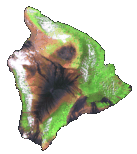 JASON VI: Island Earth
JASON VI: Island Earth
A voyage to the volcanoes, observatories and unique environments of Hawaii
February 27 - March 11, 1995
Jason Project Voyage VI embarks on an expedition to Hawaii, the world's most isolated spot of land where fantastic
adaptation of pioneering species has created a unique biological
laboratory. Scientists will study the effects of new species,
including humans,
on this fragile environment, and at the same time look backwards in
time to the origins of life - and outward to the
planets. Scientists are studying the world's most active volcano,
Kilauea,
to learn how the earth was formed billions of years ago, how vast
primordial volcanic eruptions created the atmosphere, oceans, and
perhaps even the microenvironments that made life possible. Scientists
are searching for the unknown source of the volcanic energy - the
so-called "hot-spot" deep
below the surface that powers the seismic forces so evident here -
and comparing the Earth's
volcanoes to those on Mars
, Venus,
and
Io, a moon of Jupiter to learn more about those environments and
our own. Jason VI will establish a new benchmark in remote science,
giving students a chance to operate robot mechanisms to take samples
from active
flowing lava, drive a remotely operated vehicle (ROV) eventually
bound for Mars, investigate the adaptation of life-forms to unique
island environments, and observe via computer the actual infra-red
imagery from the NASA facility on
Mauna Kea, part of the world's greatest astronomical
observatory complex.
More information is available on:
Online Activities


JASON Project homepage
||
Teachers' Guide
||
Students' Corner
||
Search
Gene Carl
Feldman
(gene@seawifs.gsfc.nasa.gov)
(301) 286-9428
Todd Carlo Viola,
JASON Foundation for Education
(todd@jason.org)
![]()
![]()